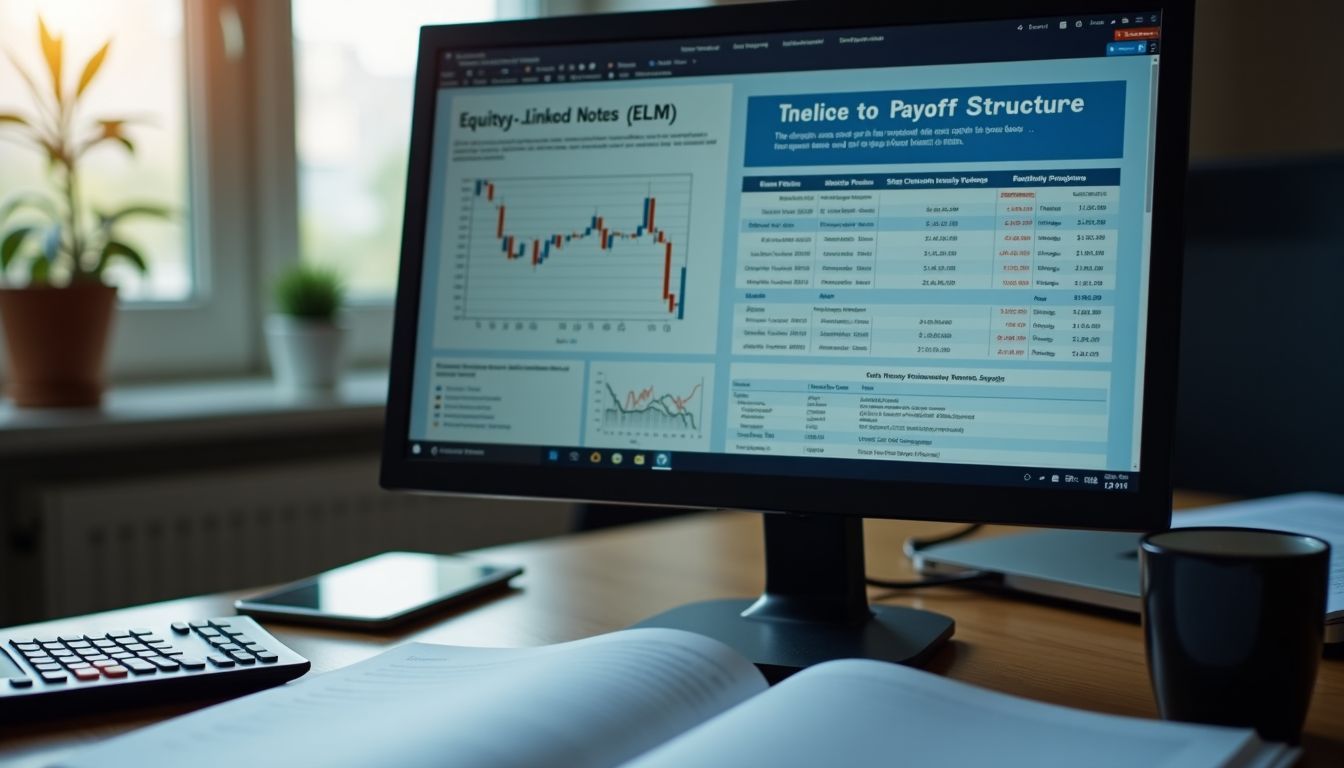Investors always look for ways to make more money. They face a big problem: how to invest safely but still have the chance to earn a lot. One answer might be Equity-Linked Notes (ELNs).
These financial instruments change the game by tying your investment’s success to how well certain stocks do. Unlike regular bonds, ELNs can grow more if the stocks do well.
One key fact is that Equity Linked Notes return depends on factors like participation rate and how the chosen stocks perform. This blog post breaks down what you need to know about “equity-linked note payoff” calculation.
We will show easy steps to figure out potential earnings from ELNs and why they matter in your investment plan. Get ready; this guide could open new doors for your investments!
Key Takeaways
- Equity-Linked Notes (ELNs) offer a chance for higher returns but come with market risks. Their success depends on the performance of stocks like those in the S&P 500 Index.
- ELN payoffs are influenced by factors such as participation rate and protection of the principal amount invested. A high participation rate often means more gains if linked equities do well.
- Calculating ELN payoffs involves looking at underlying assets’ performance, participating rates, and how these affect potential earnings versus traditional bonds.
- There are risks to consider with ELNs since poor market performance can lead to lower returns or losses compared to fixed-interest investments like regular bonds.
- Before investing in ELNs, it’s crucial to understand their unique features including payoff calculations, risks, benefits, and tax implications for better investment decisions.
Understanding Equity-Linked Notes

Equity-Linked Notes (ELNs) are a type of investment linked to the stock market. They offer features that can appeal to both conservative and aggressive investors.
Definition and features of ELNs

Equity-Linked Notes (ELNs) are a type of structured product. They do not pay a fixed interest rate like traditional bonds. Instead, their returns depend on the performance of underlying equities.
This means they carry market risk. ELNs offer investors a way to protect their capital while also providing potential for higher returns compared to regular bonds.
The payoff structure of an ELN is based on several factors. These include the participation rate and the performance of underlying assets, such as stock indices like the S&P 500 Index.
The real investment value comes from understanding this payoff calculation. Many investors may find that ELNs can outperform traditional bonds if certain conditions are met at maturity.
How ELNs work

Equity-Linked Notes (ELNs) are a special type of investment. They give investors a way to protect their capital while trying for higher returns than regular bonds. ELNs do not pay a fixed interest rate like traditional bonds.
Instead, returns depend on the performance of underlying equities. This makes them susceptible to market risk.
The payoff from an ELN is influenced by several factors. These include the participation rate and principal protection. The performance of the underlying assets plays a big role too.
For example, the S&P 500 Index can greatly affect how much an investor earns at maturity. Understanding these elements is crucial for grasping how ELNs work and calculating their true value in investments.
Structure of ELNs

Equity-Linked Notes (ELNs) are structured products. They differ from traditional bonds because they do not pay a fixed interest rate. Instead, their returns depend on the performance of underlying assets, such as equities.
This means ELNs can offer higher returns than regular bonds as long as the relevant index, like the S&P 500 Index, reaches a certain level at maturity.
The payoff structure includes several factors. The participation rate is crucial in determining how much investors earn based on asset performance. Investors also benefit from some principal protection with ELNs.
Understanding these features helps in calculating their real investment value and makes it essential for investors to grasp how these notes work before investing further into risks and benefits associated with them.
Calculating the Payoff of Equity-Linked Notes

Calculating the payoff of equity-linked notes involves specific methods. These calculations depend on factors like the underlying assets and the participating rate.
Valuation methods

Investors must analyze these factors to determine the investment’s value.
The performance of a key index, like the S&P 500 Index, plays an important role in this calculation. If the relevant index or asset reaches a certain level at maturity, ELNs can outperform traditional bonds.
Understanding valuation methods helps investors grasp how market risk affects their returns from these structured products.
Payoff structure
The payoff structure of an Equity-Linked Note (ELN) is different from that of traditional bonds. ELNs do not pay a fixed interest rate. Instead, their returns depend on the performance of underlying assets, like stocks.
Investors might see higher returns if the linked equity performs well.
Key factors influence this payoff structure. The participation rate determines how much the investor earns based on asset performance. Principal protection may also apply, which helps safeguard initial investments against losses.
For example, if the S&P 500 Index does well by maturity, it can lead to better returns than regular bonds for investors in an ELN. Understanding this payoff calculation is crucial for anyone interested in maximizing returns from these structured products.
Participating rate
Participating rate plays a key role in Equity-Linked Notes (ELNs). It determines how much of the underlying asset’s gains an investor will receive. For example, if the participating rate is 80%, investors get 80% of the increase in value from the linked equity.
This feature helps to balance risk and return.
Investors should understand that a high participating rate can lead to greater returns, but it also means more exposure to market risks. ELNs do not offer fixed interest rates like traditional bonds.
Their returns depend on how well the underlying assets perform, which adds complexity to calculating payoffs for these structured products.
Underlying assets
The next topic focuses on underlying assets. Equity-Linked Notes (ELNs) depend heavily on the performance of these assets. The underlying assets can include stocks, stock indexes, or other securities.
For example, the performance of the S&P 500 Index is crucial in calculating an ELN’s payoff.
Investors face market risk with ELNs since they do not offer a fixed interest rate like traditional bonds. Instead, returns rely on how well the underlying assets perform over time.
This setup allows ELNs to potentially outperform standard bonds if the relevant index reaches a certain level at maturity. Understanding these elements helps investors gauge their risk and potential rewards from equity-linked notes effectively.
Risks and Benefits of Equity-Linked Notes

Equity-Linked Notes (ELNs) offer unique advantages to investors. These notes can provide higher returns compared to traditional bonds, but they also carry risks tied to market performance.
Benefits of ELNs
Equity-Linked Notes (ELNs) offer several benefits to investors. They provide a chance for higher returns compared to regular bonds. Investors can protect their capital while benefiting from the performance of underlying equities.
For example, if an investor holds an ELN linked to the S&P 500 Index, they may earn more when the index performs well.
The payoff structure is another advantage of ELNs. Returns depend on factors like the participation rate and principal protection. Since these notes do not pay a fixed interest rate, there is potential for greater gains if the relevant index or asset reaches certain levels at maturity.
This feature makes ELNs appealing as structured products in today’s market.
Risks of ELNs
Equity-Linked Notes (ELNs) come with risks that investors must understand. They do not offer a fixed interest rate like traditional bonds. Instead, their returns depend on the performance of underlying equities.
This makes them vulnerable to market risk. If the equity index performs poorly, an investor may receive less or even lose some capital.
The performance of the S&P 500 Index is crucial in determining ELN payoffs. If this index does not reach certain levels at maturity, ELNs might underperform compared to regular bonds.
Investors should carefully consider these risks before investing in ELNs and analyze their investment strategies accordingly.
How to Evaluate and Invest in Equity-Linked Notes

When evaluating equity-linked notes, investors should consider several key factors. They must assess risks and returns carefully to make informed investment choices.
Factors to consider
Investors must think about several factors before choosing Equity-Linked Notes (ELNs). Market risk plays a big role. ELNs do not provide fixed interest rates like traditional bonds.
Their returns depend on how well underlying equities perform. For example, the S&P 500 Index often influences payouts. The payoff structure also matters. It includes the participation rate and principal protection.
Tax implications are another important factor to understand. These investments may have different tax treatments compared to other options. Knowing these details can help investors make informed choices and maximize their returns from ELNs.
Investment strategies
Equity-Linked Notes (ELNs) offer unique investment strategies. Investors can focus on the performance of underlying assets, like the S&P 500 Index. These notes do not provide fixed interest rates, which means returns depend on market movements.
Capital protection is a key feature that makes ELNs appealing to many.
Focusing on participating rates is also crucial. A higher participation rate often leads to better returns when the index performs well. Understanding tax implications helps in planning for overall gains as well.
Investors can maximize their returns from ELNs by choosing wisely based on risks and benefits while evaluating their options against traditional bonds and other investments.
Tax implications of ELNs
Tax implications can greatly affect Equity-Linked Notes (ELNs). Investors should know that ELNs do not offer a fixed interest rate like traditional bonds. The returns depend on the performance of underlying equities.
This makes ELNs subject to market risk, which can influence tax outcomes.
Long-term capital gains may apply if investors hold their ELNs for over a year before selling. Short-term gains may be taxed at ordinary income rates if sold sooner. Understanding these differences is crucial for anyone looking to invest in structured products like ELNs since the payoff calculation and its taxation can vary widely based on market performance.
Next, it is important to look at how to evaluate and invest in Equity-Linked Notes effectively.
Tips for maximizing returns from ELNs.
Investors can maximize returns from Equity-Linked Notes (ELNs) by understanding the payoff calculation. The performance of underlying assets plays a key role. A higher participation rate often leads to better returns, so it is wise to choose ELNs with favorable terms.
Capital protection is another important feature that investors should consider while assessing risks.
Monitoring market trends, especially the S&P 500 Index, helps in making informed decisions. If this index performs well and reaches a certain level at maturity, ELNs may outperform traditional bonds.
Being aware of tax implications also aids in improving net returns from investments in these structured products.
FAQs
Q1. What is an Equity-Linked Note Payoff Calculation?
Ans. Equity-Linked Note Payoff Calculation is a method used to figure out the returns from equity options, which are part of structured product pricing.
Q2. How does risk analysis factor into Equity-Linked Note Payoff Calculations?
Ans. Risk analysis plays a key role in unlocking the secrets of these calculations. It helps you understand your investment risks before making decisions about equity-linked notes.
Q3. Are Equity-Linked Notes considered derivatives?
Ans. Yes, they are! Derivatives like equity-linked notes have their value based on underlying assets such as stocks or bonds.
Q4. What's the importance of understanding Equity-Linked Note Payoff Calculations?
Ans. By understanding how to calculate payoff for these notes, investors can make informed decisions and manage their potential risks better.




